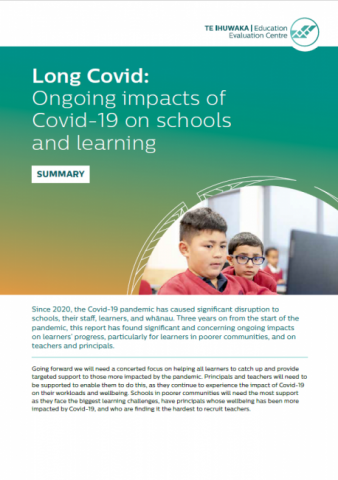Summary
Since 2020, the Covid-19 pandemic has caused significant disruption to schools, their staff, learners, and whānau. Three years on from the start of the pandemic, this report has found significant and concerning ongoing impacts on learners’ progress, particularly for learners in poorer communities, and on teachers and principals.
Going forward we will need a concerted focus on helping all learners to catch up and provide targeted support to those more impacted by the pandemic. Principals and teachers will need to be supported to enable them to do this, as they continue to experience the impact of Covid-19 on their workloads and wellbeing. Schools in poorer communities will need the most support as they face the biggest learning challenges, have principals whose wellbeing has been more impacted by Covid-19, and who are finding it the hardest to recruit teachers.
Whole article:
Long Covid: Ongoing impacts of Covid‑19 on schools and learning - Summary1. How are learners doing?
Learners’ wellbeing has improved.
Learners feel happier overall, with more than two thirds (68 percent) of learners reporting they feel happy most or all of the time, an increase from 61 percent in 2021, and 62 percent in 2020.
Figure 1: Learners: I feel happy (most or all of the time)

We found the most important reported driver of happiness at school is being connected to friends. Other drivers of learners’ happiness are feeling safe from Covid-19, and having an adult who cares for them at school.
Learners are feeling more connected to their friends. Three quarters of learners (76 percent) report feeling connected to their friends, compared with just under two thirds (64 percent) in 2021 and two thirds (66 percent) in 2020.
Learners are less worried about Covid-19. Three quarters (75 percent) of learners are now feeling safe from Covid-19, which is up from just over half (58 percent) after lockdown in 2020.
Figure 2: Learners: I feel safe from Covid-19 over time
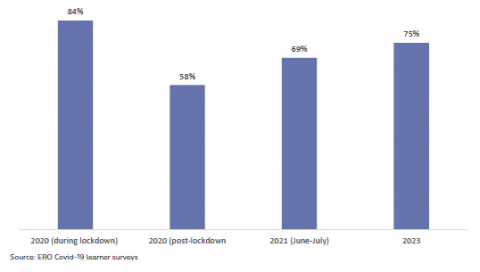
Attendance and behaviour are concerning
Covid-19 has had a serious impact on attendance. Overall regular attendance dropped as low as 40 percent in Term 2 of 2022, reflecting high rates of Covid-19-related absences through illness and isolation. By the end of 2022, regular attendance had only recovered to 51 percent, suggesting Covid-19 disruptions have led to longer term impacts on attendance.
Figure 3: Percentage of students attending school regularly in Term 4 from 2019 to 2022
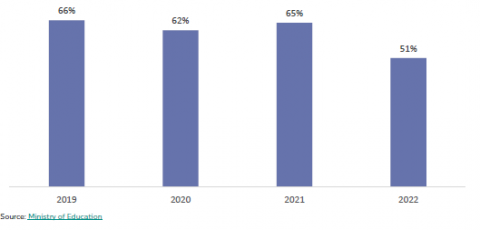
Challenging behaviour remains a significant issue. Four in 10 (41 percent) principals report that learner behaviour is worse or much worse than they would expect at this time of year, which is not significantly different from 2021 (39 percent).
Learners’ progress and achievement are increasingly impacted
Principals are increasingly concerned about learning, with nearly half (43 percent) of principals saying that learning is worse than they would expect at this time of year, a substantial increase from 27 percent in 2021. A quarter (26 percent) of principals say their learners who are struggling are two or more curriculum levels behind.
Figure 4: Principals reporting learning being worse than they would expect at this time of year
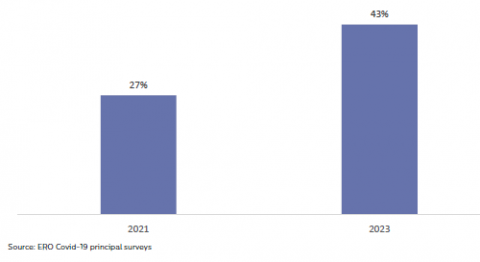
Principals and teachers are most concerned about writing, with half (51 percent) of principals and nearly half (44 percent) of teachers surveyed reporting writing as the learning area of biggest concern.
NCEA attainment has fallen. Attainment rates for NCEA Level 2 are below where they were in 2019, before the pandemic. From 2020 to 2022, modifications were made to award additional Learning Recognition Credits. If these were not in place, attainment in 2022 would have been even lower.
Learners in poorer communities have been more impacted
Principals and teachers in schools in poorer communities are much more concerned about their learners’ progress. Over half (53 percent) of principals from schools serving poorer communities say that student learning is worse than expected, compared to a third (31 percent) of principals serving schools in better-off communities.
Figure 5: Principals from low socio-economic status (SES) and high SES schools who say learning progress is worse or much worse than expected
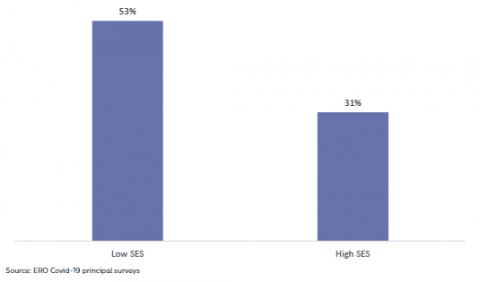
Learners in poorer communities are further behind. Principals in schools serving poorer communities are more than three times as likely as those serving better-off communities to say that their struggling learners are behind by two curriculum levels or more (46 percent compared to 14 percent).
NCEA Level 2 attainment has fallen for learners in poorer communities. The gap between schools in poorer and better-off communities for NCEA Level 2 attainment has widened from 14.5 percentage points in 2019 to 17.8 percentage points in 2022.
Figure 6: NCEA Level 2 attainment of schools serving low and high socio-economic communities
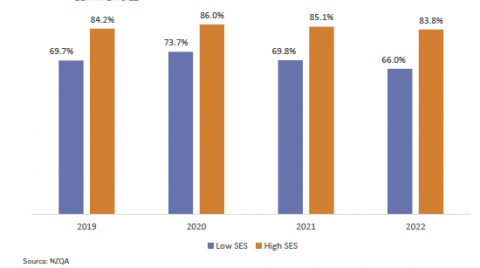
Māori learners’ progress has been more impacted
Māori learners are less positive about their learning progress, and NCEA Level 2 outcomes have fallen. Fifty-seven percent of Māori learners say their learning progress has been good this term compared to 61 percent of non-Māori learners. Māori learners’ NCEA Level 2 attainment has fallen to 64.1 percent in 2022, which is the lowest it has been since 2014. The gap between Māori and non-Māori learners’ NCEA Level 2 attainment has increased from 10.4 percentage points in 2019 to 13 percentage points in 2022.
Figure 7: NCEA Level 2 attainment of Māori learners (2022)

Pacific learners feel more positive, but their learning has been more impacted
Pacific learners are more likely than others to enjoy their learning, but their NCEA attainment has fallen. Positively, the proportion of Pacific learners enjoying their learning is greater (63 percent) than for non-Pacific learners (52 percent). However, Pacific learners' attainment of NCEA Level 2 has fallen to 67.3 percent in 2022 (down from 71.3 percent in 2019) and the gap between Pacific learners and non-Pacific learners has increased (from 6.7 percentage points in 2019 to 8.1 percentage points in 2022).
Learners from ethnic communities face greater wellbeing challenges
Fewer learners from ethnic communities feel cared for by an adult or teacher at school. Only 37 percent of Middle Eastern, Latin American, and African (MELAA) learners, and 43 percent of Asian learners, report they have an adult at their school who really cares about them compared to 51 percent of all learners. This matters, as we have found that it is a key driver of happiness at school.
Additionally, our data suggests that MELAA learners are less likely than all learners to feel happy most or all of the time. This is consistent with the finding in ERO’s report Education for All Our Children that MELAA learners report lower wellbeing than others.
Figure 8. Learners who feel they have an adult who cares about them at school by ethnicity (2023)
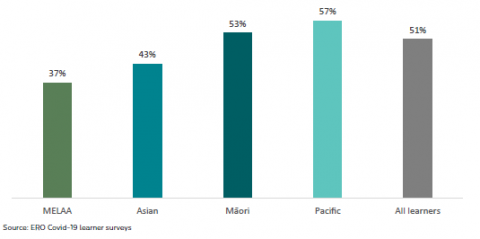
2. How are teachers and principals doing?
Covid-19 impacts on schools have accumulated. Only a fifth (19 percent) of principals in 2023 believe their school has recovered from disruptions caused by Covid-19. This compares to 37 percent in 2021.
Despite this, there are some indications that teachers’ wellbeing has improved. Teachers we surveyed report being happier at work in 2023 compared to 2020 and 2021, and more connected to their teaching teams. More data would be needed to be confident that this is a real trend.
Figure 9: Teacher wellbeing over time
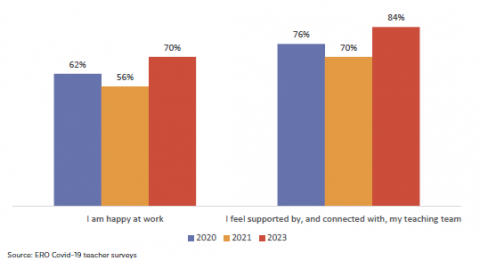
However, increasing numbers of principals need support for their wellbeing. Covid-19 pressures have accumulated and, in 2023, four in 10 (41 percent) principals report needing more support, which is up from 26 percent in 2021. Nearly a third (30 percent) of principals say they had accessed support for their wellbeing in the past year.
The most important reported driver of principals’ happiness is how manageable they are finding their workloads. Other key drivers are feeling connected to and supported by their leadership team, and having schools that have recovered from disruptions.
Workload manageability is a concern. As the impact of Covid-19 continues, only a quarter (26 percent) of teachers report their workload as being manageable (down from 42 percent in 2020), and only 16 percent of principals say their workload is manageable (down from 26 percent in 2020).
Figure 10: Teachers and principals who say their workload is manageable over time (2020-2023)
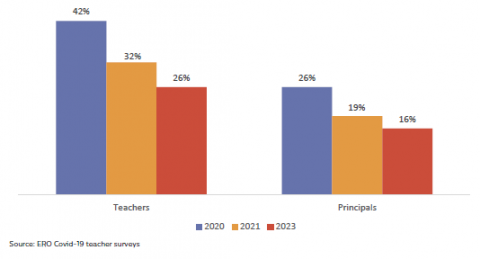
Principals of small schools and female principals are struggling more. We continue to find that the smaller the school, the more principals struggle with their workload. Principals of very small schools (58 percent) were much more likely to find their workload unmanageable compared to principals of very large schools (28 percent). We also found that female principals (45 percent) are more likely to find their workload is unmanageable compared to male principals (38 percent).
Filling vacancies is a concern. Nearly a quarter of principals (23 percent) say they are struggling to fill vacancies in 2023. Principals of schools in poorer communities are finding it particularly difficult (31 percent) compared with those in better-off communities (18 percent).
3. What do we need to do?
The cumulative impact of the past three years means that education in New Zealand has ‘Long Covid’ – a situation that will not easily bounce back to business as usual, with:
- learning gaps for all learners
- increasing inequities in outcomes
- principals and teachers who are struggling.
If unaddressed, the impact of these issues will continue to be felt over the coming decade as learners make their way through school, and principals and teachers may choose to leave the profession.
To recover from ‘Long Covid’ in education, ERO recommends action in three areas:
- focusing now on making up for lost learning opportunities
- targeting learning support for those who have been most impacted by the pandemic
- supporting principals and teachers.
a) Making up for lost learning opportunities
ERO recommends that, in 2023, everyone in education focuses on helping all learners to catch up on the learning they have missed. This means:
- Getting more learners to school every day to maximise their time for learning, for example:
- through schools’ attendance strategies, increasing understanding of the importance of attendance and awareness of how often learners are attending school
- by identifying and tackling specific barriers to attendance.
- Understanding and addressing learning gaps of all learners, for example by:
- being clear where learners should be at in all year levels and subjects, and planning early - this includes diagnostic, formative, and summative assessments, identifying barriers to learning, and having plans to tackle those barriers
- prioritising addressing learning gaps in reading, writing, and numeracy, including through the wider curriculum
- monitoring the effectiveness of remedial responses and adapting as necessary.
- Addressing these gaps through accelerating learning, for example by:
- helping learners, parents and whānau understand their own progress through timely, relevant, and tailored feedback
- as the new common practice model is adopted, focus on using an adaptive teaching approach, recognising that learners learn at different rates, and require different forms and levels of support
- providing tailored group and individual acceleration programmes by scaffolding learning to help students who need support so they can continue to progress.
b) Targeting support to those who most need it
ERO recommends that, in 2023, we put in place significant, targeted, and tailored learning support for learners who need it the most. This means:
- Identifying which learners have been most impacted, for example by:
- recognising the particular challenges faced by schools and learners in poorer communities
- teachers, counselling staff, teacher aides, and other staff working together to assess learner needs – including knowing barriers to learning
- using school-wide data to make informed decisions. This includes identifying patterns of attendance, academic achievement, behavioural and socio-emotional needs, engagement in school, and interaction with peers.
- Having multi-tiered, targeted, and sufficiently intensive support for learning, for example by:
- providing explicit and systematic instruction – this has been found to be effective in reading, writing, and mathematics
- breaking down content or tasks to enhance clarity, adapting lessons whilst maintaining high expectations for all learners, and making sure learners have opportunities to meet those expectations.
- Connecting and working with parents and whānau to support learning, for example by:
- increasing engagement of parents and whānau, teachers, and learners, in particular engaging quickly and more often where there are concerns
- clarifying learning objectives, skills, and knowledge necessary to achieve desired learning outcomes, and providing information to support parents and whānau.
c) Supporting principals and teachers
ERO recommends that, in 2023, we increase support for principals and teachers. This means:
- school boards ensuring they have a focus on supporting principal wellbeing
- increasing wellbeing support for principals and teachers and targeting it to those who need it the most
- supporting principals to deal with staff absences, turnover, and vacancies.
4. Actions already underway
In response to the impacts of Covid-19, the Government has already undertaken a range of actions to support learners, teachers, and principals. These include:
For learners:
- The Attendance and Engagement Strategy and the School Attendance Turnaround Package to get learners back to school more regularly.
- Loss of learning initiatives, including targeted funding for additional teaching and tutoring support for students in Years 7-13 who most need opportunities to catch-up.
For teachers:
- Reduced staffing ratios for Years 4-8 from 1:29 to 1:28 by the beginning of 2025.
- Free access to counselling to help teachers deal with the mental health impacts of Covid‑19.
- Study awards, sabbaticals, and study grants for teachers to complete further study and participate in professional learning activities.
For principals:
- Access to a range of programmes and funding to help principals manage their wellbeing.
- Providing access to a range of sabbaticals, training, and support.
- Supporting recruitment by:
- speeding up processing of Limited Authority to Teach and New Teacher applications
- providing help for principals and boards to recruit overseas teachers.
Conclusion
Around the world, Covid-19 is having an ongoing impact on schools and learning. Learners have had to focus on learning through lockdowns, community outbreaks, and constant change. While learners are feeling better about their learning now, Covid-19 has left a legacy of increased behaviour concerns, lower attendance, and learning gaps. We need to work together, supporting teachers and principals, to make up for learning gaps and get our learners back on track.
What ERO did
For this report, ERO has focused on the experiences of learners, principals, and teachers. We received responses to surveys from:
- 3,052 learners in Years 4 to 13, from 98 schools
- 1,209 principals
- 349 teachers, from 64 schools.
The responses came from primary, intermediate, composite, and secondary English-medium schools across the country, of a range of sizes from very small to very large, and across urban and rural locations.
We compared these responses to the findings from our previous Learning in a Covid-19 World series of reports. We have also conducted statistical analyses to understand the contribution of different reported factors to wellbeing and workload outcomes.
The survey was active between 8 March and 31 March 2023.
ERO recognises that learners’, teachers’, and principals’ wellbeing are impacted by Covid‑19 along with, for example, recent extreme weather events and cost of living pressures.
ERO is very grateful for the time of those we surveyed while researching for this report. We would like to thank all the learners, teachers and principals for generously sharing their experiences around Covid-19.
